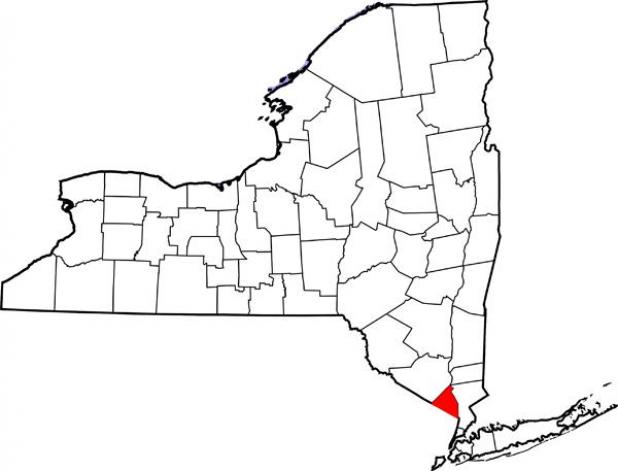
In Rockland County, shaded in this map of New York state, 276 people had died from the coronavirus by April 20.
Winckler offers view of NY county with most cases per capita

China is on the other side of the world. Italy is an ocean away. New York, though in the same country, is still plenty distant from the people of northeastern Colorado.
The epicenters of coronavirus activity have gotten closer, but it can still be difficult to grasp the severity of the pandemic when it seems so far removed from the here and now. Thanks to precautions being taken by the community, Holyoke has remained largely free of COVID-19, but one of our own offers some insight into what life looks like when the coronavirus is allowed to spread.
Christie Winckler lives in Rockland County, just north of New York City. Of the 62 counties in New York, Rockland has the highest number of cases per capita with 2,893 positive cases per 100,000 people as of Monday, April 20. Working at one of the county’s two hospitals, Winckler has a unique perspective of the coronavirus outbreak.
Both of the hospitals in Rockland County are community hospitals, and though they’re not the size of the massive facilities found in the city, each has more than 250 beds. Winckler, who called Holyoke home from 1992-2011, has worked at the Rockland County hospital since 2015. As a registered nurse, she worked in the ER there for four years and currently is employed as a nurse educator. That means she’s responsible for onboarding new nurses, a job that’s become ever more important in light of the coronavirus.
In March, New York hospitals were asked to double their bed capacity. Of course, having more beds means the hospital needs additional staff as well. As a result, Winckler has been training 25 people each day to meet that need. These are employees of the hospital system who have been displaced from their usual roles and are being trained to act as med-surg nurses to handle the increased number of patients. Last week, Winckler began training the volunteer pool as well.
Winckler said that her hospital hasn’t reached 100% of its doubled capacity, but they are caring for about 250 more patients than normal, and that’s no small task. The hospital has gone from having one critical care unit to five, and the need for critical care nurses simply can’t be overstated.
By now, most people are familiar with the need for ventilators in responding to the coronavirus, but that’s only part of a much bigger picture, Winckler explained. Even with sufficient ventilators, additional nurses are needed to run them. On top of that, medications needed to support the patients who are on ventilators are running short.
All of this is a drastic change from just a month and a half ago. Winckler remembers hearing about the novel coronavirus early on and thinking that it would play out much like the SARS outbreak in 2003. But then they closed Disneyland, and she knew this would be different. The next day, March 13, President Donald Trump declared the COVID-19 outbreak a national emergency. From there, things escalated rapidly.
“Nothing prepared me for this,” Winckler said.
About a week after the declaration, things really blew up, she recalled. In that time, New York state went from 421 positive cases and no coronavirus deaths to 7,102 cases and 46 deaths. Before long, such numbers would seem small. Last week, things did slow down some, but that was after a six-day stretch of daily coronavirus deaths exceeding 700 in New York.
In Rockland County, which has a population of about 325,000, confirmed cases rose to 9,364 over the weekend, and the death toll rose to 276. For reference, if Phillips County saw such rates, they would equate to 123 cases and three deaths.
As patients continue to be admitted with COVID-19, it’s a strain on the hospital and its staff. It’s a different disease than what they’ve treated before. The unknowns coupled with potential shortages of personnel and equipment make for a stressful environment.
Some people get the coronavirus and truly have no symptoms, making it easy for them to unwittingly spread it to others. There are 20- and 30-year-olds dying with no comorbidities, Winckler said. A couple of babies tested positive at her hospital, and one child under 10 has died. There are people who seem fine but then suddenly crash, and it can kill quickly. Many have died alone because the risk of spreading the coronavirus to visitors is too great.
Winckler noted that a number of employees at her hospital have gotten sick themselves. She has friends who have tested positive too. Thankfully some have already recovered. There have been moments when Winckler worried she had it herself, but so far she’s remained safe.
Of course, many people do recover from COVID-19, and the hospital celebrates those who do.
“Chances are you’ll be fine,” Winckler said. “But if you’re in an overrun hospital, your chances are worse.” At the end of the day, that’s the goal of social distancing and stay-at-home orders: to keep the patient numbers at any one time low enough that hospitals aren’t overrun.
Looking back, it’s easy to think that if people had simply isolated early on, there wouldn’t be more than 13,000 coronavirus deaths in New York already. They’re not just a number, Winckler reflected. They were people — loved ones, mothers, fathers, police officers, scientists.
“It’s heartbreaking.”
The past can’t be changed, Winckler acknowledged, but staying home now is what will keep the coronavirus from spreading to unmanageable numbers in the future.
Though she spends most of her time at work or at home these days, Winckler said that it is surreal to see so many businesses closed in the community. Much like Holyoke — and probably most places — there are people in Rockland County who follow the orders and people who don’t. Some wear masks. There are people who are hoarding supplies. Winckler’s seen her church and other gatherings taken online.
At the moment, there is much recognition of the health care workers and all that they’re doing. In Rockland County, EMS paraded around the hospital in honor of those working inside. At the grocery store, Winckler and other health care workers get to go to the front of the line, and people call them heroes. From her perspective, though, she’s just doing her job.
“The true heroes are the ones who are staying home,” Winckler said. “You’re the warriors. You’re killing the virus.”
